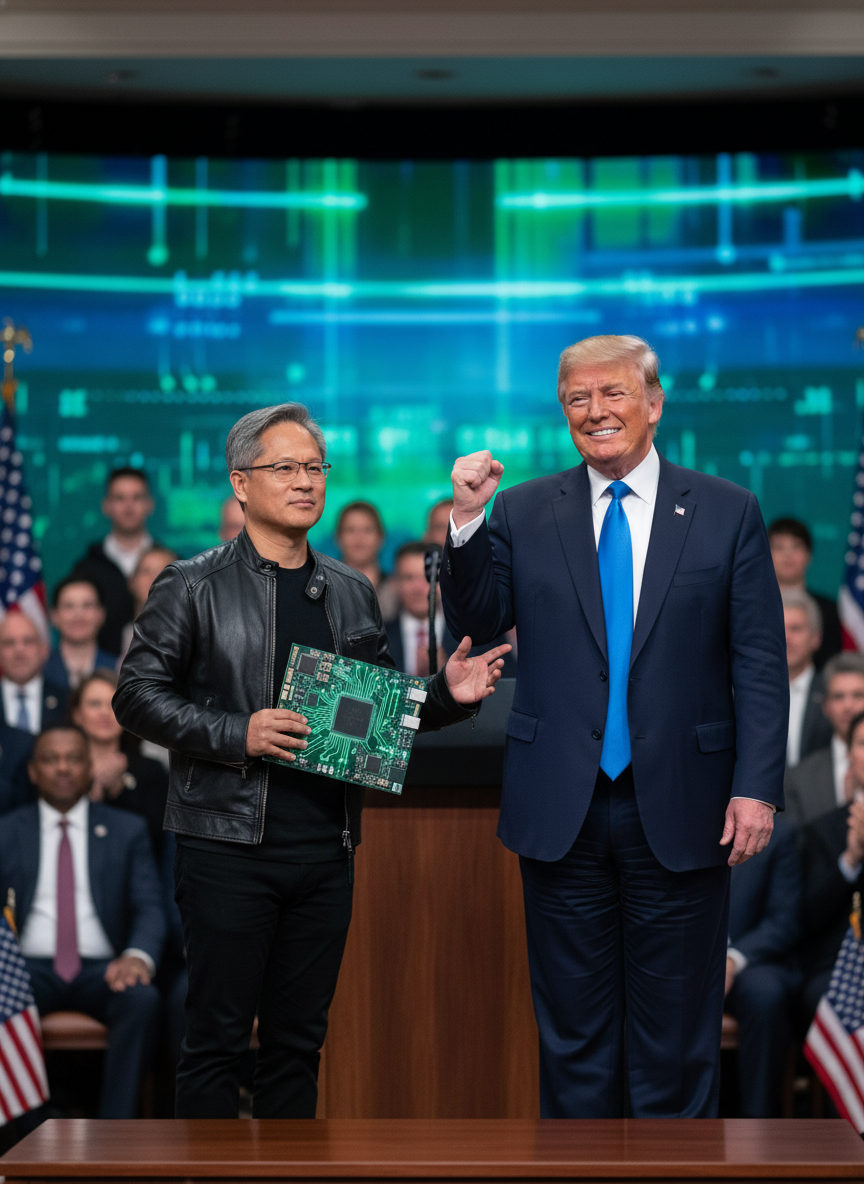Nvidia's Market Cap Surpasses $5 Trillion Amid AI Optimism

Nvidia Soars Past $5 Trillion Market Cap on AI Boom
October 29, 2025 (Local Time) – Nvidia achieved a monumental milestone, exceeding a market capitalization of $5 trillion, driven by the surging growth of the artificial intelligence (AI) industry. This surge is attributed to investor sentiment, particularly focused on tech stocks, concentrating on the AI sector, leading to a sharp rise in Nvidia's stock price. Nvidia dominates the AI chip market, including graphics processing units (GPUs), and has experienced explosive growth in recent years alongside advances in AI technology. Specifically, the increasing demand for AI technology in various sectors, such as data centers, autonomous driving, and robotics, has positioned Nvidia's GPUs as essential components. This trend is expected to continue, further solidifying Nvidia's position as a leading company in the AI era. Market experts express positive assessments of Nvidia's growth potential and anticipate further expansion through continued technological innovation and market expansion. However, challenges remain, including intensifying competition and regulatory scrutiny, making Nvidia's ability to overcome these hurdles a focal point.

Nvidia CEO Jensen Huang attended a developer event (GTC) in Washington D.C., detailing Nvidia's AI-related investment plans and business outlook. In his keynote address, he emphasized Nvidia's continuous investment in AI technology development and its commitment to expanding the AI ecosystem through innovative products and solutions. Nvidia is making substantial investments in developing next-generation AI chips to deliver more powerful and efficient AI computation capabilities. Huang also highlighted Nvidia's collaboration with various industries to broaden the application of AI technology, expecting AI to create new value in healthcare, finance, manufacturing, and other sectors. Nvidia's proactive investments and business expansion are expected to further accelerate the growth of the AI market, reinforcing its position as a key player driving the AI era. However, concerns have been raised about Nvidia's monopolistic market dominance, prompting discussions about the need for enhanced regulations to ensure a fair competitive environment.
Jensen Huang identified Nvidia's AI chips, Blackwell and the new Rubin model, as future growth drivers, projecting these next-generation chips to propel Nvidia's revenue growth into the next year. He explained that the Blackwell chip offers superior performance compared to existing chips, specifically optimized for large language model (LLM) learning and inference. The Rubin model, as a successor to the Blackwell chip, will provide enhanced performance and new features, further accelerating AI technology advancement. Nvidia anticipates these next-generation chips will secure its competitive edge in the AI market, enabling it to provide high-performance AI solutions to a broader range of customers. Market experts express excitement about Nvidia's next-generation chips, foreseeing their potential to reshape the AI landscape. However, some analysts caution that competitors are not far behind and that Nvidia must maintain continuous technological innovation and agile responses to market changes to succeed in the next-generation chip market.
Jensen Huang also predicted that Nvidia's latest chips will generate a massive $500 billion in future revenue, demonstrating strong confidence in Nvidia's growth potential. He stated that Nvidia's chips play a critical role in various sectors, including data centers, autonomous driving, and robotics, and that demand for Nvidia chips will continue to rise with the increasing demand for AI technology. Nvidia is maximizing AI computation capabilities through high-performance GPUs and strengthening its market competitiveness by providing optimized AI solutions to customers. Huang emphasized that Nvidia will continue to lead the AI era through continued technological innovation and market expansion, further solidifying its position as a leading company. However, some argue that Nvidia's revenue projections are overly optimistic, and factors such as intensifying competition and economic downturns could potentially slow Nvidia's growth.
U.S. President Donald Trump announced that he will discuss Nvidia's Blackwell chip during a summit with Chinese President Xi Jinping in Busan on October 30. This suggests that the U.S. government views Nvidia's AI chip technology as a crucial factor in the U.S.-China technology rivalry. The U.S. has restricted exports of Nvidia's high-performance AI chips to curb China's AI technology development, and discussions regarding these export restrictions are expected during the summit. President Trump also stated that the U.S. will actively support Nvidia's technology to contribute to strengthening U.S. national security and economic competitiveness. However, some express concerns that the U.S.'s technology sanctions against China could incentivize China to develop its own technology, potentially weakening U.S. competitiveness in the long run. Therefore, the U.S. government must adopt a careful diplomatic strategy to maintain its edge in the U.S.-China technology rivalry.
Nvidia has agreed to invest $1 billion in Finnish telecommunications equipment company Nokia, establishing a strategic partnership to develop next-generation 6G mobile communication technology. This move indicates Nvidia's strategy to expand its influence beyond AI technology into the next-generation communication technology sector. Nvidia expects to provide AI solutions necessary for 6G mobile communication technology development through its partnership with Nokia, creating new business models in the 6G era. 6G mobile communication is expected to play a critical role in various sectors, including autonomous driving, smart factories, and the metaverse, and Nvidia anticipates gaining a foothold in these future markets through its collaboration with Nokia. However, 6G mobile communication technology development requires substantial investment and technological capabilities, and Nvidia and Nokia must build a successful partnership through technological innovation and agile responses to market changes amid intense competition.
